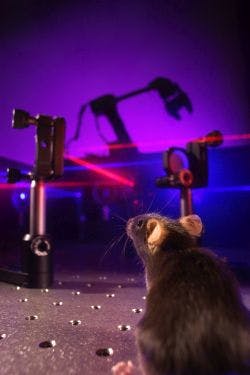Optical stimulation provides sensory feedback between brains and artificial limbs
Seeking to find out whether it is possible to transmit sensory feedback signals from artificial limbs back to the brain by stimulating neural activity in the cortex, a team of neuroscientists at the University of Geneva (UNIGE; Switzerland) discovered that not only was it possible to create an artificial sensation of neuroprosthetic movements, but that the underlying learning process occurs very rapidly. These findings were obtained by resorting to optical imaging and optical stimulation tools, offering an innovative alternative to the traditional electrode approach.
Related: Light-activated neurons control paralyzed muscles
Brain-machine interfaces (such as robotic arms) are operated by relying largely on visual perception—the robotic arm is controlled by looking at it. So, the direct flow of information between the brain and the machine remains unidirectional. However, movement perception is not only based on vision, but mostly on proprioception—the sensation of where the limb is located in space. "We have therefore asked whether it was possible to establish a bidirectional communication in a brain-machine interface: to simultaneously read out neural activity, translate it into prosthetic movement, and reinject sensory feedback of this movement back in the brain," explains Daniel Huber, professor in the Department of Basic Neurosciences of the Faculty of Medicine at UNIGE.
In contrast to invasive approaches using electrodes, Huber's team specializes in optical techniques for imaging and stimulating brain activity. Using two-photon microscopy, they routinely measure the activity of hundreds of neurons with single-cell resolution. "We wanted to test whether mice could learn to control a neural prosthesis by relying uniquely on an artificial sensory feedback signal," explains Mario Prsa, researcher at UNIGE and first author of the paper describing the work. "We imaged neural activity in the motor cortex. When the mouse activated a specific neuron, the one chosen for neuroprosthetic control, we simultaneously applied stimulation proportional to this activity to the sensory cortex using blue light."
Indeed, neurons of the sensory cortex were rendered photosensitive to this light, allowing them to be activated by a series of optical flashes and thus integrate the artificial sensory feedback signal. The mouse was rewarded upon every above-threshold activation and, 20 minutes later, once the association was learned, the rodent was able to more frequently generate the correct neuronal activity. This means that the artificial sensation was not only perceived, but that it was successfully integrated as a feedback of the prosthetic movement. In this manner, the brain-machine interface functions bidirectionally.
The researchers think that the reason why this fabricated sensation is so rapidly assimilated is because it most likely taps into very basic brain functions. Feeling the position of our limbs occurs automatically without much thought and probably reflects fundamental neural circuit mechanisms. This type of bidirectional interface could someday enable more precisely displacing robotic arms, feeling touched objects, or perceiving the necessary force to grasp them.
The research team is now examining how to produce a more efficient sensory feedback. They are currently capable of doing it for a single movement, but are looking into the possibility of providing multiple feedback channels in parallel. The research sets the groundwork for developing a new generation of more precise, bidirectional neural prostheses.
Full details of the work appear in the journal Neuron; for more information, please visit http://dx.doi.org/10.1016/j.neuron.2017.01.023.
BioOptics World Editors
We edited the content of this article, which was contributed by outside sources, to fit our style and substance requirements. (Editor’s Note: BioOptics World has folded as a brand and is now part of Laser Focus World, effective in 2022.)
